Afghanistan-India relations
This is a collection of articles archived for the excellence of their content. |
Development collaboration
2012-21
Aug 28, 2021: The Times of India
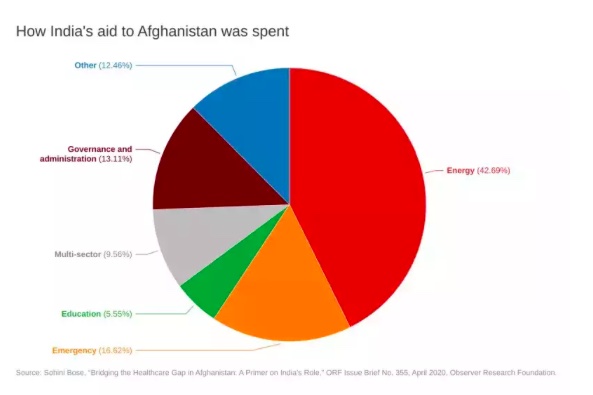
From: Aug 28, 2021: The Times of India
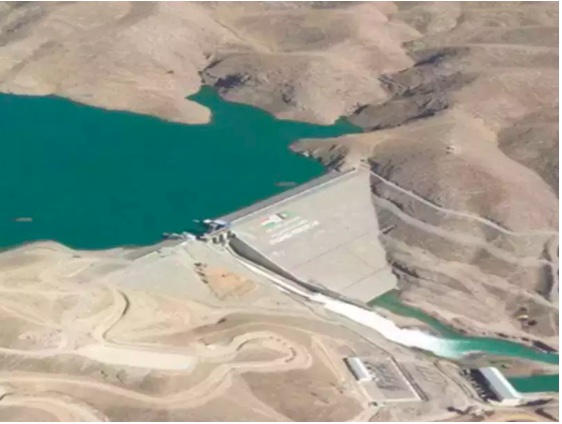
From: Aug 28, 2021: The Times of India
$3 billion and counting
India has so far given over $ 3 billion in aid to Afghanistan for over 400 development and rebuilding projects spread across the 34 provinces of the country.
Five pillars of development
India’s current development programmes in Afghanistan are centered around — Infrastructure projects, human resource, humanitarian assistance, enhancing trade and investment and high-impact community development projects.
A gift from India
In 2015, Prime Minister Narendra Modi inaugurated the new Parliament building built by India as a gift to Afghanistan. Built at the cost of $90 million, the building’s consultant was India’s Central Public Works Department. The central bronze dome of 32 meter diameter and 17.15 meter height is considered to be the largest dome in Asia.
The dam of friendship
In June 2016, Prime Minister Narendra Modi along with then Afghanistan President Ashraf Ghani opened the India-Afghanistan Friendship Dam in Herat province. The 42MW dam also provides irrigation to 75,000 hectares of land. Initially named Salma Dam, it was renamed by the Afghan cabinet to strengthen ties between the two countries.
The gateway to the outside world
The 217-km highway was built by India's Border Road Organisation at a cost of $152 million. Over 300 BRO engineers and technicians, and 70 ITBP personnel were involved in the construction, six of whom were killed in insurgent attacks. The south-end of the highway provides land-locked Afghanistan connectivity to Iran and the Arabian Sea. The northern end of the highway connects to the 2,200-km Ring Road, which connects major Afghan cities.
The Light Kabul project
The Power Grid Corporation of India helped build the Chimtala substation with the goal of "Light Kabul . The 220kv substation supplies additional power to Kabul. Passing over the Salang Range at an altitude of 3,800m, the transmission line is 202km long.
The Stor Palace
The Stor Palace was restored by Agha Khan Trust for Culture, the Indian and the Afghan government. The restoration work started in 2013 and was inaugurated in 2016.
Healthcare
In 2019, three Indian health organisations signed a contract worth $6.5 million with Afghanistan government to help improve health infrastructure in the country. The Indira Gandhi Hospital for Child Health, built in 1996 by India, is the largest paediatric hospital in Afghanistan and treats over 300,000 children annually. India also conducts training of the Afghan doctors and paramedics at AIIMS in Delhi.
Education
Six per cent of the total assistance from India is directed towards education. As of 2020, more than 65,000 Afghan students have studied in India under various scholarship programmes. India has granted 3000 scholarships to young Afghan women to pursue higher studies in India. India also provided vocational training to a large number of women in Afghanistan. In 2020, two girls' schools were built with India's assistance.
Defence
According to a 2011 agreement, India agreed to assist in the training, equipping and capacity building programmes for Afghan National Security forces. India also gave four Mi-35 attack helicopters to Afghanistan.
Diplomatic relations
2023: Taliban appoint envoy but incumbents refuse to leave
Sachin Parashar, May 16, 2023: The Times of India
NEW DELHI: The appointment of an envoy by the Taliban has landed India in a peculiar situation with the Afghan ambassador who has held the fort till now, Farid Mamundzay, and other diplomats appointed by the previous Ashraf Ghani government refusing to relinquish charge.
The embassy in a statement accused Taliban’s pick Qadir Shah of spreading misinformation and running a baseless and unsubstantiated campaign against the mission. Shah had been working as trade counsellor with the embassy when he was redesignated as charge d’affaires by the Taliban.
In the first public confirmation of the Taliban move to appoint an envoy to India, its chief of political office in Doha Suhail Shaheen had told TOI, as reported on Monday, this was a rational decision that would pave the way for better ties with India. Shah, however, has apparently been denied entry into the embassy since he was re-designated.
Caught in a catch-22, the Indian government is yet to reveal its hand on the issue even though, as reports from Kabul disclosed on Monday, the Taliban foreign ministry issued an order weeks ago - on April 25 - replacing the ambassador with its own charge d’affaires. India had extremely close ties with the Ghani government but, without endorsing the Kabul dispensation, it has also sought to engage the Taliban, most notably in the form of aid diplomacy that has seen it supplying over 40,000 MT of wheat to Afghanistan and also by reopening its embassy.
While rejecting the claim of Shah, who had earlier written to the MEA saying he was taking over as the charge d’affaires, the embassy in its statement also appreciated the "consistent" position of the Indian government for supporting the interests of the Afghan people, while at the same time "not recognising the Taliban regime in Kabul, as it has been the case with democratic governments around the world". It said the embassy had worked closely with Indian authorities on humanitarian issues, including the supply of Covid-19 vaccines, medicines and food.
The decision to appoint its own envoy here is in line with efforts by the Taliban, overriding the lack of international recognition for the dispensation in Kabul, to take control of more and more Afghan embassies around the world. A Taliban spokesperson was quoted as saying in March this year that the 'Islamic Emirate of Afghanistan’ had sent diplomats to 14 countries – including Russia, Iran, China, Turkey and Pakistan – and efforts were on to take charge of other diplomatic missions.
These efforts have met with limited success though as the international community remains wary of recognising the government in Kabul, not least because of a Taliban crackdown that has seen them blocking employment and education for women and girls.
Ghani Government diplomats shut mission
Sep 29, 2023: The Times of India
The Afghan embassy in India has suspended all operations after the ambassador and other senior diplomats left the country for Europe and the United States where they gained asylum, three embassy officials said on Friday.The embassy, which was of the ousted Afghanistan government before Taliban takeover, had been financially struggling for two years.The development could pave the way for Taliban diplomats to take over, Bloomberg reported.
NEW DELHI: The Afghan embassy in India has suspended all operations after the ambassador and other senior diplomats left the country for Europe and the United States where they gained asylum, Reuters reported quoting three embassy officials.
The embassy had been financially struggling for two years. It was being run by diplomats appointed by the previous Ashraf Ghani government that was overthrown by the Taliban in 2021.
The development could pave the way for Taliban diplomats to take over, Bloomberg reported.
India has not recognized the Taliban government which seized power in Afghanistan in August 2021.
It evacuated its own staff from Kabul ahead of the US withdrawal from Afghanistan two years ago and no longer has a diplomatic presence there.
India has said it will follow the lead of the United Nations in deciding whether to recognize the Taliban government. Meanwhile, embassy officials said that at least five Afghan diplomats have left India.
The Indian government will now take over the diplomatic compound in a caretaker capacity, one of the Afghan officials said.
The ministry of external affairs is seeking to verify the authenticity of a letter it received regarding the embassy’s closing in the absence of the ambassador and reports of infighting among embassy workers.
“The authenticity of the communication and its contents are being examined,” said a government source, reacting to the development.
“This is in the context of the ambassador being out of India for past many months, steady departure of diplomats to third countries reportedly after receiving asylum as well as reports of infighting among embassy personnel,” he added.
The ‘ambassador’ himself, Farid Mamundzay, had been living abroad for many months even though he claimed to be running the embassy operations.
The announcement by the embassy cited lack of support from the Indian government for closing down.
“Despite numerous requests regarding key concerns about the diplomatic mission’s situation, educational initiatives, and support for consular services, humanitarian aid coordination, and commercial assistance to Afghan traders, necessary actions were not taken, or minimal support was provided by the relevant authorities,” it said.
Mamundzay and other diplomats had earlier blocked the appointment by the Taliban of an Afghan official, Qadir Shah, as charge d’affaires.
Had he been allowed to take over, Shah would have been the Taliban’s first envoy to India. Mamundzay and others, however, did not allow Shah to even enter the mission.
India is one of a dozen countries with a small mission in Kabul to facilitate trade, humanitarian aid and medical support. Bilateral trade in 2019-2020 reached $1.5 billion, but fell drastically after the Taliban government took office.
Earlier this month hundreds of Afghan college students living in India despite the expiry of their student visas staged a demonstration in New Delhi to urge the Indian government to extend their stay.
(With inputs from agencies)
Economic cooperation
$3 billion cooperation, till 2018
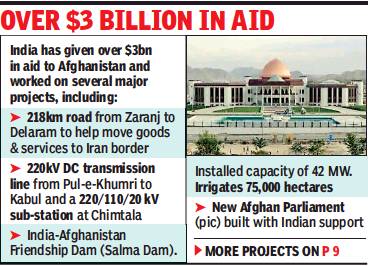
From: Sachin Parashar, We’re changing lives: India rebuts Trump’s jibe on Af, January 4, 2019: The Times of India
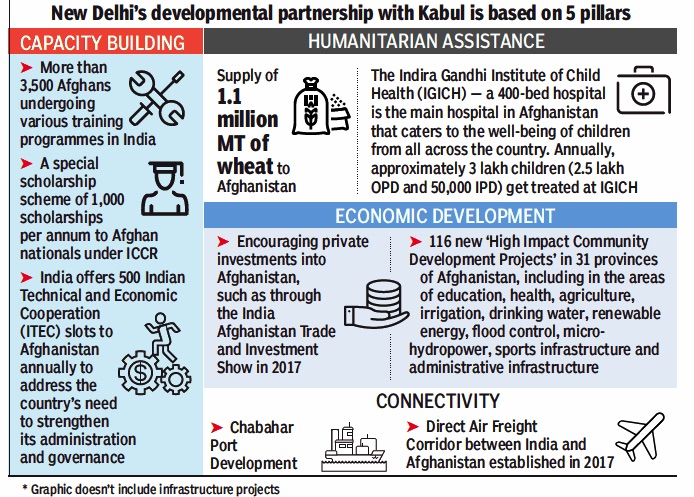
From: January 4, 2019: The Times of India
US Prez Mocks PM Modi For ‘Building Library’
Even as US President Donald Trump called on India to play a bigger security role in Afghanistan, ridiculing in the process Prime Minister Narendra Modi for having built what he incorrectly claimed was a library, New Delhi brushed the putdown aside, saying there was no question of “putting boots on the ground”.
The government hit back, with sources here saying India’s developmental assistance to the war-torn country, which exceeds $3 billion, can transform human lives there. In what was seen as a deeply offensive remark, Trump had described India’s assistance as “five hours of what we spend”.
Trump, who seems to have mistaken Afghanistan’s Parliament building built by India for a library, was prodding New Delhi to do more in Afghanistan militarily but India would have none of it. The US president’s comments came in the context of his defence of the decision to pull out of Afghanistan, with many arguing that this harms American security interests and lets down allies. India has consistently resisted deploying active military personnel except as part of UN missions.
The Vajpayee government did not send troops as part of the US-led invasion of Iraq in 2003 after a brief inhouse debate and this has not changed even in the case of nearby Afghanistan.
India is largest donor to Afghanistan in region
Government sources here reiterated India’s position that the country does not send its armed forces abroad except under “the specific mandate of UN Peacekeeping operations”.
In his first 2019 cabinet meeting, Trump called for Russia, India and Pakistan to shoulder more responsibility for Afghanistan’s security.
“I could give you an example, you know I get along with India and the PM Modi, and he’s constantly telling me he built a library in Afghanistan,” Trump said. “You know what that is? That’s like five hours of what we spend. And he tells it — and he’s very smart — and we’re supposed to say, ‘Oh, thank you for the library’. I don’t know who’s using it in Afghanistan,” he added, in remarks considered offensive even by the Afghan authorities.
Sources said India’s partnership with Afghanistan was built on the specific requirements worked out with the Afghan government.
“It is aimed at the welfare of the people of Afghanistan and for a tangible improvement in the lives of its people. India seeks to build capacities and capabilities of Afghan nationals and its institutions for governance and delivery of public service, develop socio-economic infrastructure, secure lives and promote livelihood,” said a government source while elaborating on India’s ties with Afghanistan.
This is the first time that the US has sought to trivialise India’s efforts in rebuilding Afghanistan after the US war to oust Taliban. The Obama administration had always lauded India’s contribution and the role it played in improving the lives of people. While India remains open to supplying military equipment and has even gifted attack choppers to the government in Kabul, the government has steadfastly maintained that it won’t put boots on the ground.
With its assistance exceeding $3 billion, India is the largest donor to Afghanistan in the region. The government sees its partnership with Afghanistan as based on five pillars — infrastructure projects, humanitarian assistance, connectivity, capacity-building and economic development. India’s infrastructure projects, like the Zaranj-Delaram road and Salma Dam, which has been generating electricity since 2016 and releases water to irrigate 75,000 hectares of land, have generated a lot of goodwill with locals, sources said.
Indian investments in Afghanistan
As in 2021 July
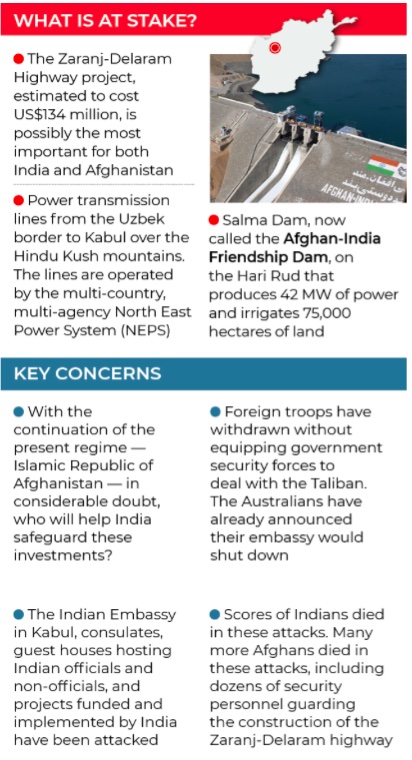
From: July 16, 2021: The Times of India
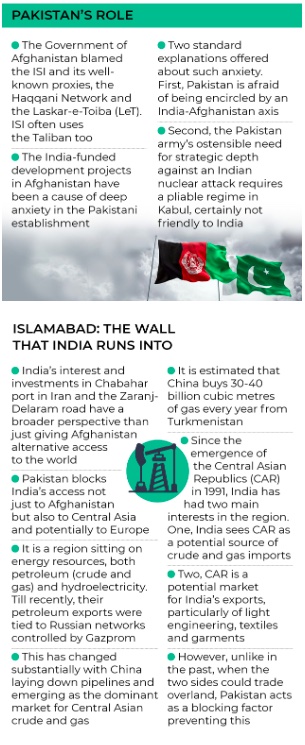
From: July 16, 2021: The Times of India
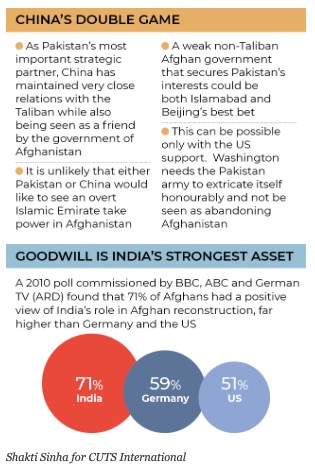
From: July 16, 2021: The Times of India
See graphics:
Indian investments in Afghanistan, As in 2021 July-I
Indian investments in Afghanistan, As in 2021 July-II
Indian investments in Afghanistan, As in 2021 July-III
Taliban- India relations
2000-2024
Shubhajit Roy, Jan 18, 2025: The Indian Express
Shubhajit Roy, Diplomatic Editor at The Indian Express, has been a journalist for more than 25 years now. Roy joined The Indian Express in October 2003 and has been reporting on foreign affairs for more than 17 years now. Based in Delhi, he has also led the National government and political bureau at The Indian Express in Delhi — a team of reporters who cover the national government and politics for the newspaper. He has got the Ramnath Goenka Journalism award for Excellence in Journalism ‘2016. He got this award for his coverage of the Holey Bakery attack in Dhaka and its aftermath. He also got the IIMCAA Award for the Journalist of the Year, 2022, (Jury’s special mention) for his coverage of the fall of Kabul in August 2021 — he was one of the few Indian journalists in Kabul and the only mainstream newspaper to have covered the Taliban’s capture of power in mid-August, 2021.
Foreign Secretary Vikram Misri has met Taliban Foreign Minister Amir Khan Muttaqi, India’s highest-level contact yet with the regime since it came to power in 2021. The meeting was the culmination of the incremental progress of India’s policy of ‘cautious engagement’ with the Taliban – how has it negotiated the relationship over the last three and a half years?
Back in 2000, following a meeting with Mullah Abdul Salam Zaeef, the Taliban envoy to Pakistan, Vijay K Nambiar, India’s High Commissioner to Islamabad at the time, assessed the chances of engagement with the regime in Kabul as bleak.
“I realised that there was no way in which we (Taliban and India) are going to be truly connected with each other in any kind of an understanding,” he said, according to Avinash Paliwal’s book, My Enemy’s Enemy: India in Afghanistan, from the Soviet Invasion to the US withdrawal (2017). Nambiar believed that the Taliban were firmly in the “Pakistani circle of reasoning”, which made it difficult for India to seriously engage with them.
A quarter century later, India’s Foreign Secretary Vikram Misri last week led a delegation of senior Indian diplomats at a substantive meeting in Dubai with Amir Khan Muttaqi, Foreign Minister of the second Taliban regime.
The meeting was the culmination of the incremental progress of India’s “cautious engagement” with the Taliban who took power in Kabul after the Ashraf Ghani government collapsed three and a half years ago. How has India negotiated its relationship with the Taliban since they took power?
First contact in Doha
On August 31, 2021, hours after the last US military aircraft left Afghanistan, India made its first official contact with the Taliban – at the request of the new rulers in Kabul, Ambassador to Qatar Deepak Mittal met Sher Mohammad Abbas Stanekzai, head of the Taliban political office in Doha, at the Indian embassy. A few days before the meeting, Stanekzai, an alumnus of the Indian Military Academy (IMA) Dehradun who would become Deputy Foreign Minister in the Taliban government, had said India was “very important for this subcontinent”, and the Taliban wanted to continue “cultural”, “economic”, “political”, and “trade ties” with India “like in the past”.
Days after the Doha meeting, then Foreign Secretary Harsh Vardhan Shringla said the engagement had been “limited”, and the Taliban had indicated they would be “reasonable” in the way they “handle” India’s concerns.
After the Taliban announced a Cabinet with very little representation for ethnic minorities and without any woman, India called for an “inclusive dispens ation”. As an “immediate neighbour and a friend to [the Afghan] people”, the situation was of “direct concern” to India, New Delhi said. Days earlier, then ISI chief Gen Faiz Hameed had travelled to Kabul to guide the Taliban in their appointments.
‘Technical team’ in Kabul
That September, India described the Taliban as “those in positions of power and authority across Afghanistan”, acknowledging the group as a state actor for the first time.
In December 2021, India sent 1.6 tonnes of essential medicines to Afghanistan, signalling a political call taken in New Delhi to see the ruling regime separate from the people of Afghanistan, while also opening a window to engage with the Taliban.
In early June 2022, an official Indian delegation visited Kabul for the first time after the Taliban takeover to oversee, according to the Indian government, “delivery operations of our humanitarian assistance” to Afghanistan. The team led by J P Singh, Joint Secretary in the Ministry of External Affairs, met Foreign Minister Muttaqi.
Later that same month, New Delhi sent aid for the Afghan people impacted by a deadly earthquake in the Khost and Paktika provinces in the east of the country, and also took the incremental step of stationing a “technical team” at the embassy in Kabul to coordinate the delivery of aid. The embassy had been evacuated following the Taliban takeover.
Afghan embassy in Delhi
In December 2022, India expressed concern over the banning of women from universities, and renewed its call for an inclusive government that ensures equal rights for women and girls in all aspects of Afghan society. The MEA spokesperson referred to UN Security Council Resolution 2593, adopted on August 30, 2021 under India’s presidency, which talked about the need to uphold human rights and women’s rights, and sought a negotiated political settlement in Afghanistan.
In October 2023, the Afghan embassy in New Delhi ceased operations citing paucity of resources and personnel, and the failure to “meet expectations…to serve the best interests of Afghanistan”. After the Ambassador appointed by the Ashraf Ghani government relinquished control, two Afghan diplomats posted in Mumbai and Hyderabad volunteered to run the mission.
In January 2024, Indian diplomats based in Kabul had their first publicised meeting with Muttaqi.
A moment for engagement
In their conversations with key Taliban leaders, Indian officials have got the sense that the Taliban are “ready to engage”, and are looking for assistance to rebuild the country’s infrastructure. They are also facing challenges in governance and capacity, as many trained Afghans have left the country.
On its part, New Delhi would not like to be left behind other countries, including China, who are making significant inroads in Afghanistan. While questions have been asked over India not linking its increasing engagement with a push for improving the situation of women in Afghanistan, New Delhi has said it is committed to the welfare of the people of that country, and would act in a “realistic manner”.
The regional and global context has been highly dynamic since the Taliban came to power. Afghanistan’s neighbour Iran has been weakened considerably, Russia is fighting its own war, and the US awaits the return of Donald Trump to the White House.
The Taliban’s benefactor and ally, Pakistan, has turned into a deadly adversary, having carried out at least three bombing raids inside Afghanistan since 2021, and pushed back large numbers of Afghan refugees across the Durand Line.
India, which has been watching the state of play, has concluded that this is the time to upgrade the level of official engagement — if it is to not lose its years of investment in Afghanistan. India’s core concern remains security — to ensure that no anti-India terrorist group is allowed to operate from Afghan territory.
India has dispatched large quantities of humanitarian, medical, and food aid to Afghanistan, and discussed the rehabilitation of refugees and strengthening of cricket ties.
In his meeting with Misri, Muttaqi asked India to issue visas to Afghan businessmen, patients, and students. However, this is complicated: India does not officially recognise the Taliban government, there are security threat perceptions, and there is no functional visa section at the Indian embassy in Kabul. But New Delhi is willing to consider going ahead with stalled projects in all 34 provinces – and this is an important commitment.
Trade
2019- 2024
Harikishan Sharma, Feb 17, 2025: The Indian Express
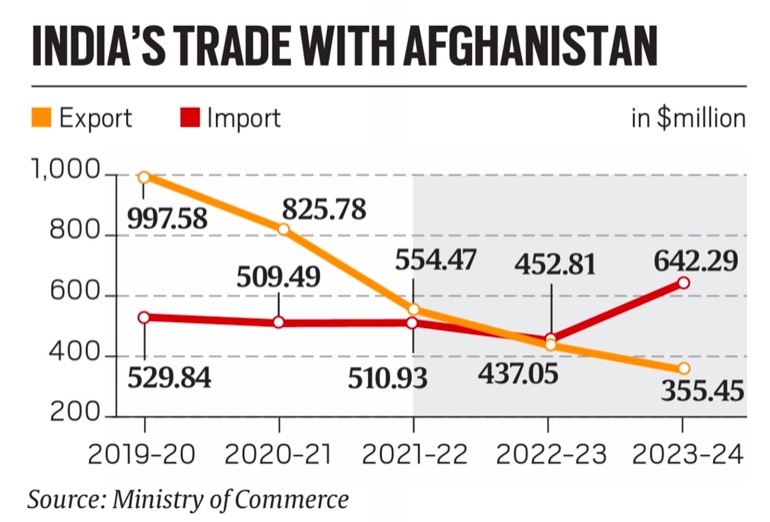
From: Harikishan Sharma, Feb 17, 2025: The Indian Express
Fig, asafoetida, apple & saffron major imports; trade gradually resuming with ‘cautious optimism’, say experts
India’s trade equation with Afghanistan has witnessed a shift after the Taliban’s return to power in August 2021, with imports touching a record $642.29 million in 2023-24 and exports slumping to a 16-year low, creating an unusual trade deficit, reveals Ministry of Commerce data.
This shift gains significance as New Delhi has initiated its highest-level contact yet with the Taliban regime and the latter too has expressed interest in strengthening political and economic ties with India, calling it a “significant regional and economic power”.
The recent talks between India’s Foreign Secretary Vikram Misri and Taliban Foreign Minister Amir Khan Muttaqi reportedly focused on expanding trade and leveraging Iran’s Chabahar port, which India has been developing to bypass Pakistan’s Karachi and Gwadar ports.
According to government data, in 2020-21, before the Taliban takeover, the value of exports to Afghanistan stood at $825.78 million and imports at $509.49 million. India’s exports fell sharply to $554.47 million in 2021-22, $437.05 million in 2022-23 and $355.45 million in 2023-24.
Conversely, imports from Afghanistan have seen a steady increase from $509.49 million to $510.93 million in 2021-22 and an all-time high of $642.29 million in 2023-24; the only exception being 2022-23 when imports saw a drop of $58.12 million to $452.81 million.
Before this, the last time India saw a trade deficit ($0.73 million) with Afghanistan was in 2000-01.
In 2023-24, the top items India imported from Afghanistan were mainly agricultural produce — figs, asafoetida, raisins, apples, garlic, saffron, fennel seeds, almonds, apricots, onions, pomegranates and walnuts.
Last year, India imported 29,123 tonnes of figs and almost the entire quantity came from Afghanistan. Similarly, Kabul was the biggest source of asafoetida, raisins and garlic.
Apple imports
In the last two years, Afghanistan has also emerged as a major apple supplier to India, surpassing traditional suppliers like Italy and the US. In the last fiscal, it was the third-biggest supplier of apples to India. The only two countries ahead of it were Iran and Turkey.
India’s exports to Afghanistan include mainly medicines, vaccines, soybean meal, and garments.
In the first seven months (April-October) of the current financial year, India’s trade deficit with Afghanistan has reached $125.27 million, with New Delhi’s exports valued at $196.03 million and imports at $321.30 million.
India’s bilateral trade with Afghanistan rose to its all-time high of $1.5 billion in 2019-20, just before the Covid-19 outbreak. In the following years, it fell to $1.3 billion during the second Covid wave in 2020-21 and $1.06 billion in 2021-22. It fell below the 1 billion mark to $889 million in 2022-23, but again rose to $997.74 million in 2023-24. In the first seven months of the current fiscal, the bilateral trade between the two countries has reached $517.32 million. It is important to note that bilateral trade of $997.74 million with Afghanistan during 2023-24 accounted for just 0.09% of India’s total $1,115-billion trade, and Kabul ranked 82nd among New Delhi’s trading partners.
Dry fruits demand
Trucks loaded with Afghan dry fruits come from Kandahar to Wagah border via Pakistan. Traders attribute the jump in imports of Afghan dry fruit to two factors — rising demand post-Covid and ease of trade after Taliban’s takeover of Kabul.
Deepak Agrawal, Secretary, Nuts and Dry Fruits Council India (NDFCI), said: “Post-Covid, the dry fruit industry is growing at a rate of 15-20% annually. India imports a significant quantity of dry fruits, with no duty on those originating from Afghanistan. Contrary to perception, trade has actually become easier post-Taliban takeover.”
Saffron over poppy
Senior diplomat and former Ambassador Jayant Prasad said India’s export figures do not reflect the value of items sent as humanitarian aid to Afghanistan in recent years.
“Now, India has unfrozen visas for businessmen from Afghanistan; therefore, trade will increase, but it will be incremental first… Returning to the prior 2001 days will take a little time…,” Prasad said.
He said, “It is heartening to see that saffron is coming from Afghanistan. The Afghan government had encouraged the cultivation of saffron to replace the poppy cultivation in the country. It was started during 2008-09 and is still being continued. Their objective was to encourage saffron cultivation so that people would leave poppy cultivation.”
“India-Afghanistan trade reflects a blend of economic cooperation and strategic priorities, underlining India’s focus on regional stability. Despite Afghanistan’s political challenges and reliance on alternative routes like the Chabahar Port in Iran, trade continues, supported by India’s investments in projects like the Salma Dam and Afghan Parliament. Initiatives like the 2017 air freight corridor and duty waivers on Afghan imports have eased trade and strengthened goodwill through humanitarian aid,” said Ajay Srivastava, founder, Global Trade Research Initiative (GTRI ), a trade research body.
YEAR-WISE DEVELOPMENTS
1980: Indira coaxed Pak to join strategy against the Afghan “occupation”
The report said Indira sought to form a regional grouping to exert diplomatic pressure on the Soviets to confine their "activities" to Afghanistan.
Indira Gandhi in an interview post the Emergency period in India. (Source: ThamesTv/YouTUbe) Worried over Soviet invasion of Afghanistan, Prime Minister Indira Gandhi tried to persuade then Pakistan President Zia-ul-Haq in 1980 to join an Indian-sponsored regional strategy to effectively deal with the “occupation”, according to a declassified CIA report. The report said Indira sought to form a regional grouping to exert diplomatic pressure on the Soviets to confine their “activities” to Afghanistan.
The Pakistani establishment was also concerned that India might take advantage of the tension along the Af-Pak border to intimidate Pakistan or that India might launch a preemptive strike against its nuclear facilities. According to the report declassified last week, in the wake of the invasion, Pakistani leadrship was also apprehensive about the potential for Soviet and Indian efforts — separate or joint– to undermine Pakistan’s stability.
“Immediately after the 1979 Soviet invasion of Afghanistan, Indira Gandhi — who had just returned to power–tried to persuade President Zia’s government to adopt an Indian-sponsored regional approach to the Soviet occupation,” the report said. Rejecting India’s proposal, the Pakistani officials characterised the plan to the US diplomats as “hegemonistic” and instead accepted American offers of arms to counter the Soviet threat from Afghanistan.
On its part, India feared that the revival of any US-Pakistani military ties and the expanded US naval presence in the Inbdian Ocean will increase super-power competition in a region where India aspired to have unchallenged dominance. “Senior Indian officials believed the extent of the threat posed to India and the region by the Soviet invasion would depend on whether Pakistan became a ‘buffer state’ or whether it became a ‘confrontation state’ by accepting major military help from outside powers, allowing foreign bases on its soil,” the CIA assessed.
In response to Indian arguments that Pakistan’s acquisitions of US arms threatened India, Zia in 1981 had proposed a non-aggression pact with New Delhi. The report said New Delhi continued to parry Pakistani initiatives on the pact. Talking about various issues involving Indo-Pak ties, the CIA said Islamabad feared that India’s desire for “regional pre-eminence threatens Pakistan’s survival”.
2016: "Heart of Asia Conference", Amritsar
The Hindu, December 6, 2016
There are good reasons why the ‘Heart of Asia’ conference, part of a 14-nation process begun in 2011 to facilitate the development and security of Afghanistan, is so named. The obvious one is geographical, as Afghanistan lies at the junction of Central, South and East Asia, and also of the ancient trading routes from China and India to Europe.
It is also a focal point for the region’s biggest challenge of terrorism; some of the far-reaching battles against al-Qaeda, Islamic State, etc. will be decided on the battlegrounds of Afghanistan. The case Mr. Ghani made was clear: progress and development in Afghanistan are meaningless and unsustainable without peace, and peace is contingent on Pakistan ending support to terror groups such the Haqqani network and Lashkar-e-Taiba.
As a result, the measures India and Afghanistan have envisaged, such as land trade from the Chabahar port and a dedicated air corridor between Delhi and Kabul, have proved to be insufficient, even as Afghanistan is connected more closely via a rail line from China’s Yiwu and Tehran. The Heart of Asia process thus remains critical to forging cooperation to realise Afghanistan’s potential to be a vibrant Asian “hub”.
Shahtoot Dam
Announced in 2020
Indrani Bagchi, November 25, 2020: The Times of India India’s plan to build dam to aid Afghanistan likely to unnerve Pakistan
NEW DELHI: The government announced that it would build the Shahtoot Dam on Kabul river in Afghanistan, which will bring relief to the residents of Kabul but greatly unnerve neighbouring Pakistan, which is likely to protest vehemently.
Foreign minister S Jaishankar announced at the Geneva donors conference, “India had just concluded with Afghanistan an agreement for construction of Shahtoot Dam, which would provide safe drinking water to 2 million residents of Kabul city.” The announcement is likely to be received with dismay in Pakistan, which has accused India of choking its water supplies from Kashmir and Afghanistan.
The plan for the dam is not new, it has been discussed and feasibility assessed at least for the past three years. But this is the first time India pledged it in an international conference, which makes it significant. The dam on the Maidan river, a big tributary of the Kabul river, will ease the growing water woes of a stressed country.
“I am happy to learn of India's commitment on constructing the Shahtoot Dam on Kabul river. It is essential for drinking water supplies to Kabul which is staring at serious water shortage. We started a conversation on this in 2016. We should, together with Afghan partners, expedite work on this project for which basic ground work has been done,” former ambassador to Afghanistan Amar Sinha said.
MEA spokesperson Anurag Srivastava said, “The minister also announced launch of Phase-IV of high impact community development projects in Afghanistan, which envisage more than 100 projects worth $80 million that India will undertake in Afghanistan.” The high impact small development projects have shown to have very high levels of popular support and participation. Started in Afghanistan, India has now replicated this template in other neighbouring countries as well.
In his response, Afghan President Ashraf Ghani said, “I’d like to thank India and Iran for the Chabahar corridor and the related sea as well as air corridor.”
United Nations/ UNSC matters
2021: India votes for easing curbs on aid to Afghanistan
Dec 23, 2021: The Times of India
India has voted in favour of a UN security council resolution to grant exemption from sanctions for humanitarian assistance to Afghanistan, underlining that the Council should exercise its oversight on the delivery of assistance as well as guard against any possible diversion of funds.
“India supported the resolution to grant exemption from sanctions for humanitarian assistance to Afghanistan,” India’s permanent representative to the UN ambassador T S Tirumurti said on Wednesday. “It is important that assistance be scaled up and unhindered access be provided to UN and other agencies. In this context, India has supported the call of the international community that access to humanitarian assistance for Afghanistan should be direct and without any hindrance,” he said.
“Assistance should reach the most vulnerable first, including women, children and minorities,” he added. He said there are reports that suggest that over half the population is facing crisis or emergency levels of acute food insecurity.
“As the largest regional development partner of Afghanistan, India is willing to coordinate with other stakeholders to work towards enabling expeditious provision of much needed assistance to the people of Afghanistan,” he said. PTI